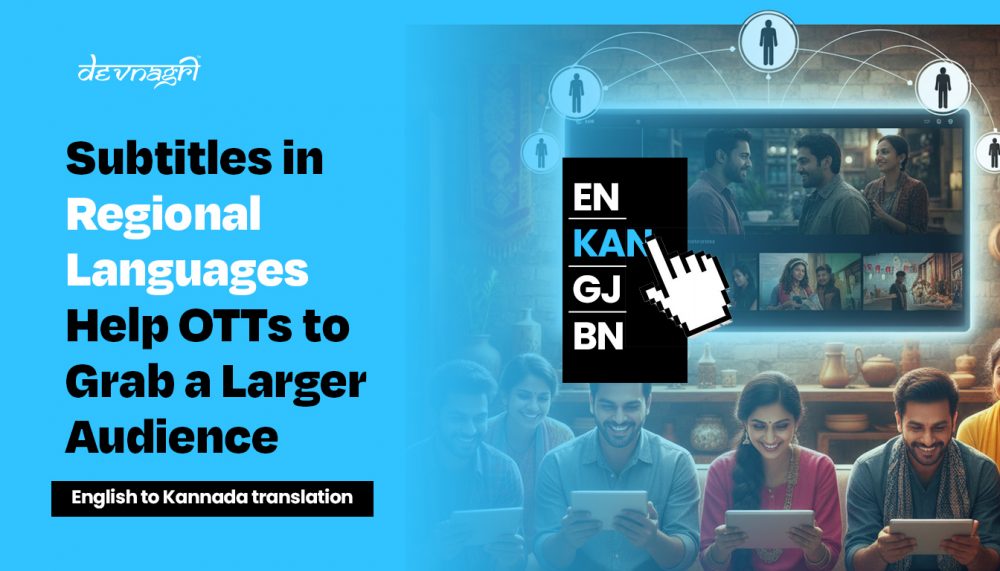Walk into any living room in Bengaluru on a Friday night and you’ll probably see the same thing that’s happening in Delhi, Mumbai, or Chennai, families huddled around a smart TV or a laptop, scrolling endlessly through an OTT platform until someone finally decides what to watch. Here’s the difference: when that choice is a Korean drama, a Hollywood series, or even a Hindi blockbuster, not everyone in the room is comfortable unless Kannada subtitles are available, as it is one of the most spoken languages in India. If they’re missing, half the room loses interest quickly. If they’re present, the story connects, the jokes land, and suddenly the show becomes binge-worthy.
That small detail is driving some very big numbers in India’s entertainment market. Subtitles, once an afterthought, now sit at the center of strategy for OTT platforms. And one of the most important directions in this shift is English to Kannada translation.
Why language is not just a feature but a growth driver
India has always been multilingual. Business leaders know the numbers, 20-plus official languages, hundreds of dialects, and audiences who are fiercely loyal to their mother tongue. But it’s one thing to know the statistic and another to see it play out in consumer behavior.
Take a look at the most-watched shows on major OTT platforms in the past two years. A huge chunk of that demand came from regional titles or international content with regional subtitles. The audience base for Kannada content is not small or fringe. Karnataka alone accounts for more than 40 million speakers, and many more live across the rest of India and abroad. When you put out content with Kannada subtitles, you’re not serving a minor group. You’re unlocking a mainstream market.
And this is the part that often gets missed. Subtitles are not just for people who “can’t understand” English. They’re for the office worker watching on mute during a bus ride, for parents who put kids to sleep and keep volume low, and for students trying to improve comprehension. Subtitles serve convenience as much as they serve comprehension.
A quick reality check: the cost of ignoring subtitles
Here’s a scenario I came across recently: a mid-sized OTT company released a European crime thriller without Kannada subtitles. Initial traction looked promising in metros. But churn data from tier-2 cities told a different story. Viewers sampled the show and dropped off within two episodes. Within weeks, reviews started mentioning the absence of regional subtitles as a reason to cancel or switch to competitors. When the company finally added Kannada subtitles, completion rates shot up and the show trended locally.
This isn’t an isolated case. Time and again, data show that local language access reduces churn. It isn’t about “nice to have” anymore. It’s about survival in a crowded streaming market.
Why Kannada matters in particular
Let’s zoom in. Sandalwood films have a loyal fanbase, and Kannada literature and theatre add depth to cultural storytelling. Younger audiences are now mixing that heritage with global tastes. A teenager in Hubli can enjoy a Marvel film in English one day, a Korean drama the next, and a local Kannada comedy on the weekend. The common link is the need for easy access, and subtitles make that possible.
English to Kannada translation bridges that gap. It allows international stories to land naturally in Karnataka while also enabling Kannada films to travel outward with English subtitles. This two-way flow strengthens not just the platforms but also the creators and the cultural ecosystem.
The expectation shift: from optional to default
Not long ago, subtitles felt optional, almost like a bonus. Today, they are expected. Open any new release on Netflix or Amazon Prime in India and you’ll see language options by default. Viewers notice quickly if something is missing. And in competitive markets, that missing element becomes the reason to switch platforms.
One interesting trend is how subtitles are used even when viewers understand the language. College students often watch global shows with subtitles turned on because it helps them catch slang, references, or fast dialogue. Professionals use subtitles when watching on mute in offices or flights. Parents use them when kids are sleeping. Accessibility has widened the scope of subtitles far beyond “translation help.”
Business leaders should see numbers, not text
When you run the numbers, the business case is clear:
- Market reach expands as soon as you localize in regional languages. Cities like Mysuru, Belgaum, and Mangalore show rising subscription numbers, and local language support accelerates that growth.
- Retention improves. Churn drops when audiences feel the platform speaks their language.
- Revenue multiplies. Advertisers look for wider, engaged audiences, and brands pay more when platforms attract strong regional clusters.
- Brand trust grows. Offering Kannada subtitles signals cultural respect, which carries long-term value in India’s fragmented but loyal markets.
It’s not about subtitles being “extra text on a screen.” It’s about the numbers behind user acquisition, churn, and ad sales.
Subtitles are only the beginning.
Once viewers get comfortable seeing Kannada subtitles, the expectation bar rises. Next comes dubbing in Kannada, app interfaces in Kannada, even marketing campaigns tailored to local audiences. Each step deepens the bond. And once that bond is created, switching costs for users rise dramatically.
For decision makers, subtitles are the entry ticket. Dubbing, interface localization, and cultural campaigns are the full strategy. Together, they build ecosystems where language is not a barrier but a growth engine.
Looking ahead
Every major report on OTT in India points to the same trend: regional languages are where the growth is. More than half of viewing hours already come from regional content, and this is set to climb as internet access deepens in tier-2 and tier-3 cities. Kannada sits right in the middle of this growth wave.
We’ve already seen Kannada films reach global festivals with English subtitles, and global content trending in Karnataka when localized properly. The appetite is there. The only question is whether platforms are ready to meet it.
Final word
Entertainment today crosses borders faster than ever, but the way people connect with stories is still rooted in language. For OTT leaders, English to Kannada translation for subtitles is not a technical step. It’s a business lever. It drives engagement, it protects retention, and it unlocks new audiences.
The companies that get this right won’t just keep pace with market trends, they’ll set the pace. And in India’s entertainment economy, that difference can decide who leads and who fades away.
Related Article: Maximizing Website Traffic with English to Kannada Translation



